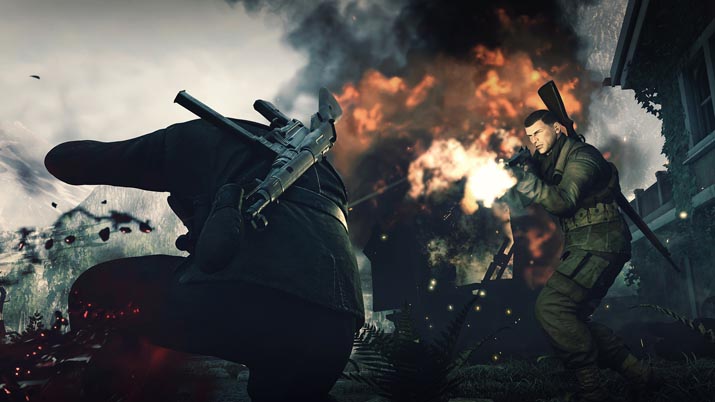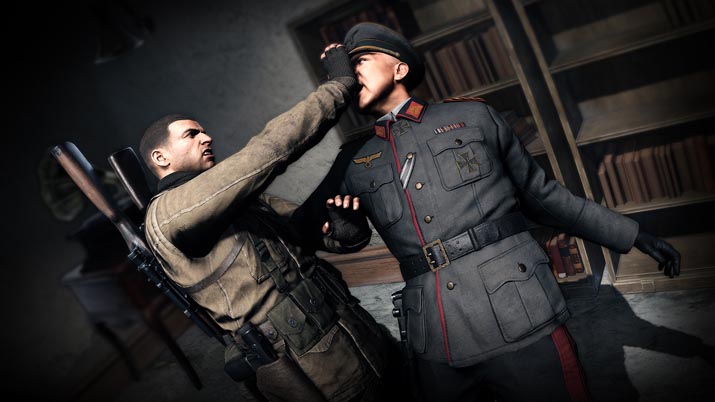Endlessly enjoyable sniping makes its return in Rebellion Development's Sniper Elite 4.
The latest entry is set shortly after its predecessor and has you step back into the shoes of the gruffly-voiced killing-machine, Karl Fairborn. At the start, Karl is tasked with taking out several Nazi officers on a Mediterranean island, as well as gathering any information on the Axis' apparent development of guided missiles. As events unfold, there are characters introduced that push the story into a more personal and less generic realm of WWII-fare, but even so, the plot is merely passable. It's told through a combination of animated art that's narrated by the protagonist and in-engine cinematics. The story mostly succeeds in that it gives a reason for killing hundreds of enemy soldiers in a variety of locales, though I doubt a reason is needed in a title like this.

The previously mentioned areas are one of the main improvements in this iteration. Sniper Elite 3's open-ended levels were a breath of fresh air after the previous entry's linearity, and Rebellion has outdone themselves this time around with areas considerably larger than ones previously seen in the series. With no vehicles to speed up travel, the developers have solved the potential issue of dull wandering in another way; by packing most of the map with side objectives. These optional tasks are evenly spread out across regions that are usually infested with enemies, which minimizes the amount of walking it takes to get back into the action. In addition to size, the maps have a greater focus on verticality as well. While you always have the option to forgo sniping in favor of close quarter tactics, the abundance of steep ridges and buildings that overlook objectives reminds you that Sniper Elite is at its best when aiming down a scope. You're also reminded of this by the unforgiving difficulty and relative inability to take a bullet, so your best shot at survival is a mixture of long-range engagements, stealth, and, most importantly, patience. To aide stealthy approaches, there are tools available, such as the new inclusion of suppressed ammo, which must be bought using in-game money. This ammo type is a scarce commodity during missions, thus encouraging players to utilize other methods for stealth as well. Tripwires, mines, and waiting for loud noises to mask an unsuppressed shot are all examples of how players are limited more by their patience than the options available to them. Being strategic is virtually mandatory at higher difficulties, where enemies are deadlier and realistic bullet ballistics makes aiming a challenge in and of itself. There were difficulty spikes towards the end of the story that made me consider lowering the difficulty, but a lot of that is due to the recklessness of my approach. A new feature to Sniper Elite 4 that helps ease the difficulty of aiming on higher settings is a range compensator for the rifle scopes. Pressing Q and E (default) will adjust the range of the scope by increments of 100 meters. I found myself using this feature often despite initially assuming I wouldn't. One small touch that was appreciated is a stat preview that compares your current gun to the one you can pick up on the ground. This ‘quality-of-life’ feature removes the guesswork or the need to memorize weapon stats.
Whether it's significant changes, like the improvement to level design, or small refinements, Rebellion has improved on the groundwork laid by Sniper Elite 3 and created a high mark for the series.

Sniper Elite 4 gets a visual upgrade as well – particularly the environments. While the expected improvements to textures, shading, and lighting are present, this title's greatest visual asset is its color-rich settings. The previous game's switch from bombed out European cities to sandy African deserts merely traded dull greys for slightly-less-dull tan colors. Here, Italian coastal towns are scattered around several missions and consist of brightly painted Mediterranean style buildings. The green, hilly landscapes and the beautiful bodies of water that surround them also brighten the aesthetics of these areas. Of course, I'd be remiss if I failed to mention the improvements to the x-ray kill cams. These brutal and painfully detailed showcases of violence show an x-ray vision of the destruction a bullet can do to the human body. They've always been increasingly grotesque, and the trend continues here, with bodies that are more realistically rendered, a larger amount of bone fragments, and the addition of kill cams during takedowns.
Content wise, there's enough to hold your interest for a good amount of time. Both the campaign and the wave-based Survival mode can be played in single-player as well as co-op. Competitive multiplayer and co-op mode Overwatchake their return; however, I didn't have access to these at the time of the review. The main appeal of these titles, to me, has always been the single-player content and luckily Sniper Elite 4's campaign is meaty enough to warrant a purchase on its own. It sports only eight levels, but completing all the side objectives, in addition to the main mission, will take you over an hour per level in most cases. Adding to the lasting appeal is the single-player unlock system where every five levels, you can choose between one of two perks. After completing the single player and most of its side objectives, I'm still at only level 23 out of 30, which creates a nice incentive to replay missions. Leveling up requires XP, which is earned by killing enemies, blowing up vehicles, and completing objectives along with challenges. There are also challenges tied to the weapons, where stat boosts and weapon skins only unlock after taking down enemies in specific ways, such as killing 50 enemies that are over 100 meters away. Rounding out the single-player content is collectibles, and there's a decent amount here. Letters, miscellaneous documents, and soldier rosters are scattered around the battlegrounds, with the latter two impacting gameplay in certain ways. The best collectibles are the stone eagles hidden around levels that, when shot, give a reward of some type, though I'm not sure what that reward is.

When it comes to music, Sniper Elite 4 presents a standard World War II orchestral affair. When enemies are on high alert, the tempo and intensity of the soundtrack increase, making shootouts more exciting, but overall it's probably not going to be something you listen to in your spare time. Other areas of sound design are expectedly top-notch. If sniper rifles didn't sound satisfactory in a series called Sniper Elite, then that'd be a pretty big oversight, but the explosive roar of the Gewehr 43, for instance, confirms that the developers know how to make a powerful-sounding gun. Most impressively, each rifle has a distinct sound; no small feat considering that with DLC, there are 11 different sniper rifles. Outside of rifles, the sound design holds its own, with pistols, submachine guns, and shotguns all sounding as they should. Ambient audio is also well executed. The roaring engines of fighter planes or the distant booms of artillery fire were appropriately immersive.
The excellent sound design improves an already quality experience and helps Sniper Elite 4 stand out from the pack.

The Verdict
Rebellion Development took the groundwork laid by Sniper Elite 3 and improved upon nearly every aspect. Its large scale environments feature an intelligent layout of objectives and abundance of sniper-aiding verticality. While Sniper Elite 4's music and story aren't going to win any awards, they aren't enough to take away from the respectable amount of content and addictive, strategy-based gameplay.

